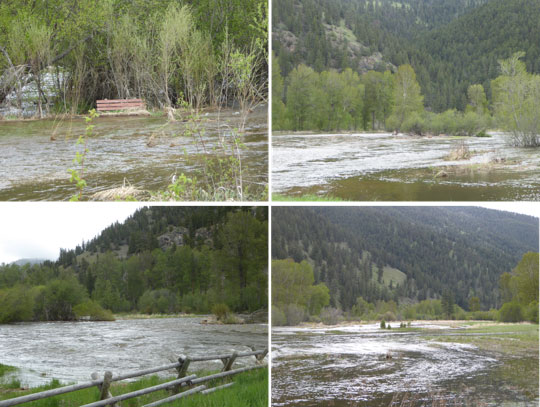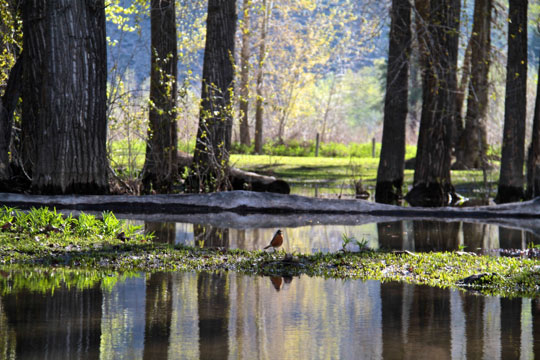
Each year my family takes me to enjoy the special Mother’s Day country brunch offered at the Esktrom’s Stage Station at Rock Creek. Rock Creek has long been the location of Mother’s Day celebrations for me. My own father could always talk my mother into celebrating the day by driving the big loop from Butte, through Anaconda, past Georgetown Lake, along Rock Creek, and back to Phillipsburg for Mother’s Day dinner. He sold the excursion as a special family Mother’s Day occasion, but we all knew what he was really doing was checking out Rock Creek for the fishing season that routinely opened the following weekend. Water levels were his interest. This year’s runoff would have caught my father’s attention.
[caption id="attachment_4123" align="aligncenter" width="540"] Rock Cree Overflowing Its Channel[/caption]
Rock Cree Overflowing Its Channel[/caption]
Indeed, water levels are on the minds of many Western Montanans this time of year. Winter snows combine with spring rains to bring rushing cool, clear water down the slope of our many mountain ranges to the valley bottoms. The water levels in mountain streams can dramatically change within hours. A placid river can turn angry overnight.
After years of working for natural resource management, I thought I had a fairly good understanding of rivers. However, it has only been since my move to Dunrovin along the Bitterroot River that I have acquired a personal, emotional connection to a specific river with its many moods and fickle nature. Understanding river ecology on an intellectual basis is not the same as watching a river day in and day out and knowing it has the potential to greatly impact your life. Like an adult becoming a parent for the first time, my relationship with rivers has forever changed. They have taken hold of me. I love them and I respect, and, at times, fear them.
Rivers aren’t subtle. They lack guile. They are influenced by the weather, the topography, and the substrate materials through which they flow. And they, in turn, modify those very same influences, serving as summer oases with cooler temperatures, excavating deep canyons through limestone mountains, or spreading out over flat riparian areas.
Rivers greet each season with boldness and commitment, freezing, thawing, flooding, shrinking. Spring is, of course, the showy season, arriving with vibrant colors and promises of sweet things to come. Rivers embrace this exuberance by overflowing their banks, spreading themselves across the land, scattering logs and debris along their paths, and carving new courses through the landscape. Spring rivers demand attention. Boiling currents carrying winter’s melting snow, water rising up to engulf green meadows, and pastures transforming into small lakes cannot be willfully ignored.
Here at Dunrovin, we have come to love this annual spring display of the Bitterroot River’s might. In an oxymoronic display of destruction and regeneration, the Bitterroot uses what it tears down upstream to build downstream. Trees fall, ponds form, channels wander, and life rushes in.
[caption id="attachment_4124" align="aligncenter" width="540"] The Bitterroot River at Flood Stage[/caption]
The Bitterroot River at Flood Stage[/caption]
Nothing hesitates or questions the existence of suddenly appearing, yet ultimately ephemeral, bodies of water. They are there and they are to be used and enjoyed. Turtles, wood ducks, muskrats, and snakes all take up residence. Great blue herons wade the shores. In years gone by, our own children rallied their friends to gather in cottonwood forests turned Bitterroot bayou for mythical canoe battles and water fights. A child’s utopian playground that was at once mysterious, ominous, and yet totally safe.
[caption id="attachment_4125" align="aligncenter" width="540"] Dunrovin Ranch’s Bitterroot Bayou[/caption]
Dunrovin Ranch’s Bitterroot Bayou[/caption]
Unseen, yet, most important, is the vegetation’s reaction to this aquatic abundance. Flooding is essential to riparian zones. Willows, grasses, and cottonwood trees all lap it up, responding with vigor and regeneration. Snow-white clouds of cottonwood seeds fall softly on the muddy soil required for germination. Healthy, multi-aged riparian cottonwood forests proclaim healthy, free-flowing rivers.
The cottonwoods evolutionary partnership with rivers is a symbiotic dance. Shallow roots are all that is needed to find water and nutrients, yet shallow roots will not hold heavy trees during high winds. Cottonwoods routinely collapse, only to be lifted by rising river waters and transported downstream to jam up against a bank or gravel bar, obstructing the river’s flow, deepening its channel, changing its course, catching sediment, tearing the nutrients from the woody tree trunks, and constructing new habitat for fish and beaver. In an endless game of leap frog, the river and the trees work together to destroy and renew. It’s a beautiful ballet.
This close association with water makes cottonwoods America’s fastest-growing native trees. But their rapid growth comes at the expense of the density of the resulting wood. It is soft. It yields easily to the beaks of woodpeckers and to gravity’s pull on large, heavy branches. Cavities form; trees are disfigured. Insects move in. Birds soon follow. The birds thrive; the forest thrives; the fish and the river thrive. They thrive together in a classic ecological symphony.
Once privy to this music, it is impossible not to notice the details. To watch the ospreys stripping the long strands of soft, decayed cottonwood bark to line their nests. To hear the pileated woodpecker’s loud drumming in the forest treetops. To wonder at a kestrel’s ability to know that ingesting cottonwood bark will relieve its pain. To smell the pungent organic brew of drenched loam and rotting duff as the Bitterroot drains its bayou in retreat, becoming a peaceful summer river.
Long hot and lazy summer days soon erase memories of bulging river banks. Waters again behave themselves by neatly confining their flows to established channels. Fishermen eagerly walk the shores and wade the ripples to spend morning and evening hours casting in the deeper pools. Laughter echoes through the valley as floaters seek cooler afternoon temperatures, bobbing along in innertubes. A sense of complacency sets in. The river is once again seen as a friendly, predictable place. Until – until the next spring arrives.
[caption id="attachment_4126" align="aligncenter" width="520"] Summer Fun on the Bitterroot[/caption]
Summer Fun on the Bitterroot[/caption]
Life along the Bitterroot is intoxicating. Rivers are living, breathing entities that are as simple as they are complex. They are earth’s arteries and veins. They represent life at its fullest; nature at its best. They nourish and sustain. All they ask of us is to listen, adapt, and learn to sing their eternal song.